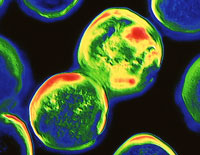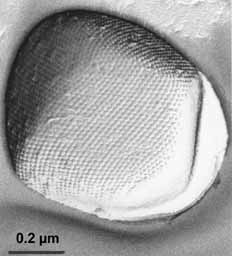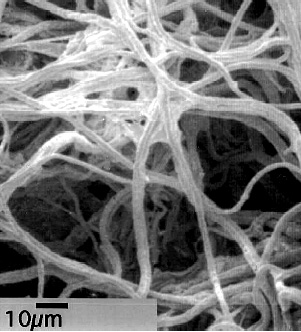Archaeoglobus
A Microbial Biorealm page on the genus Archaeoglobus

Classification
Higher order taxa:
Archaea; Euryarchaeota; Archaeoglobi; Archaeoglobales; Archaeoglobaceae
Species:
Archaeoglobus fulgidus, A. lithotrophicus, A. profundus, A. veneficus
Description and Significance
Archaeoglobus members are hyperthermophiles that can be found in hydrothermal vents, oil deposits, and hot springs. They can produce biofilm when subjected to environmental stresses such as extreme pH or temperature, high concentrations of metal, or the addition of antibiotics, xenobiotics, or oxygen. These archaeons are known to cause the corrosion of iron and steel in oil and gas processing systems by producing iron sulphide. Their bioflims, however, may have industrial or research applications in the form of detoxifying metal contaminated samples or to gather metals in an economically recoverable form.
Genome Structure
The Archaeoglobus fulgidus genome is a circular chromosome roughly half the size of E. coli at 2,178,000 base pairs. A quarter of the genome encodes preserved proteins whose functions are not yet determined, but are expressed in other archaeons such as Methanococcus jannaschii. Another quarter encodes proteins unique to the archaeal domain. One observation about the genome is that there are many gene duplications and the duplicated proteins are not identical. This suggests metabolic differentiation specifically with respect to the decomposing and recycling carbon pathways through scavenged fatty acids. The duplicated genes also gives the genome a larger genome size than it's fellow archaeon M. jannaschii. It is also noted that Archaeoglobus contained no inteins in coding regions where M. jannaschii had 18.
Cell Structure and Metabolism
Archaeoglobus species are a sulphur-metabolizing anaerobic organism whose cells are an irregular sphere with a glycoprotein envelope and monopolar flagella. The sulfur-oxide reduction pathway consists of sulphate being activated to adenylylsulphate, then reduced to sulfite and finally sulfide with adenylylsulphate reductase being the major enzyme.
Ecology
Archaeoglobus species utilize their environment by acting as scavengers with many potential carbon sources. They can obtain carbon from fatty acids, the degradation of amino acids, aldehydes, organic acids, and possibly CO as well. Higher temperatures (approx. 83oC) are ideal growth temperatures for Archaeoglobus, although a biofilm environment provides some environmental elasticity. Biofilm is composed of polysaccharides, proteins, and metals. The advantages to a biofilm environment is that extracellular enzymes will be more accessible, competition and predation can be controlled, and there is an increased resistance to antibiotics. LaPaglia and Hartzell (1997) found that one mechanism of biofilm protection was the sequestering of heavy metals. Cultures exposed to high concentrations of metals were able to integrate metals into an insoluble matrix.
Medicine
Cells protected by biofilm are difficult to destroy using conventional anti-microbial therapy, which gives them medicinal possibilities.
References
Klenk et al. 1997. The complete genome sequence of the hyperthermophilic, sulphate-reducing archaeon Archaeoglobus fulgidus. Nature 390:364-370.
LaPaglia, Christopher, Patricia L. Hartzell. 1997. Stress-Induced Production of Biofilm in the hyperthermophile Archaeoglobus fulgidus. Applied and Environmental Microbiology Vol. 63, No. 8: 3158-3163.



